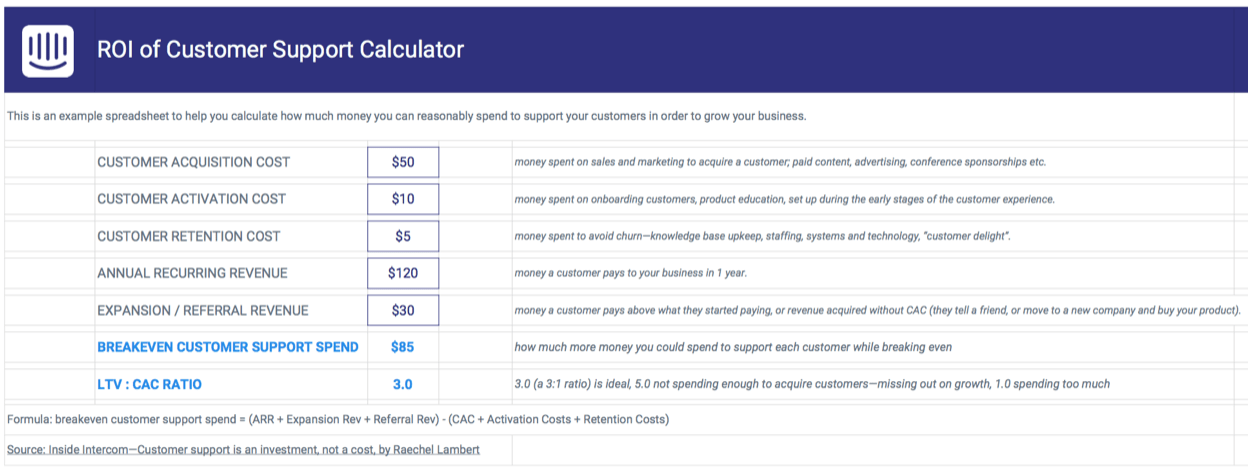
Customer support is an investment, not a cost
Main illustration: Beena Mistry
There’s no escaping the fact that supporting your customers costs money, but how much money can you afford to spend while optimizing for growth and retention?
Many companies respond to growth pressures by cutting the amount they spend on support, letting their customers’ experience suffer as a result. Reducing your spend on customer support might look tempting in the short term, but will erode your profitability in the long run – unhappy customers will simply leave.
At Intercom, we’ve found customers who talk to support are worth 2.5 times more to us in MRR than the ones who don’t. That’s why we’ve put even more emphasis on growing our support team – both in headcount, and tools for support, such as improved processes and training.
Determining how much to invest in your support can be hard. It depends on your own financials, the stage of your company, the type of product you sell, etc. At Intercom, I’ve been responsible for marketing Articles, our knowledge base product, so I’ve been thinking a lot about how and why people invest in support. Coming from the world of SaaS finance, where part of my job was creating operating plans to grow the business, I believe the best way you can answer these questions is with a calculator. Once you’ve defined some factors about your business, you’ll be able to clearly understand how much your company should spend to support your customers.
Calculating how much to spend on your customers
Start by determining each of these five elements per average customer:
- Acquisition cost: Money spent on sales and marketing to acquire a customer, e.g. paid content, advertising, conference sponsorships, etc. This is usually the biggest expense and makes up about 25-35% of Customer Lifetime Value.
- Activation cost: Money spent on setting customers up for success, e.g. onboarding new customers, product education, etc.
- Retention cost: Money spent on avoiding customer churn, e.g. knowledge base upkeep, staffing, systems and technology, etc. This is referred to in some circles as the missing SaaS metric.
- Annual recurring revenue: Money a customer pays in one year.
- Expansion/referral revenue: Any additional money a customer pays over and above their initial monthly spend, or how much additional money is collected without acquisition costs (e.g. they tell a friend, or move to a new company and implement your product there too).
Once you’ve estimated these factors you can calculate how much money you should spend supporting each customer to reach your breakeven point and your return on investment for acquiring customers.
Here are the simple formulas:
Breakeven per customer support spend = (Annual Recurring Revenue + Expansion Revenue + Referral Revenue) – (Acquisition Cost + Activation Costs + Retention Costs)
and
Lifetime Value / Customer Acquisition Cost Ratio = (Annual Recurring Revenue + Expansion Revenue) / Customer Acquisition Cost
Actionable insights
This spreadsheet will automatically calculate your breakeven customer support spend and LTV:CAC ratio.

Click above to open this spreadsheet in Google Docs, or click here to download it as an Excel file.
Most operating plans assume new customer counts. For example, if your breakeven customer support spend is $85, and you expect 1,000 new customers next year, then you can spend $85,000 more on customer support next year than you did this year while maintaining the same profit margin.
It’s up to you to determine the most effective way to spend that money – it could mean more teammates or optimizing your support tools by letting more customers help themselves.
For LTV:CAC ratio, a 3:1 ratio is ideal. 5:1 means you are not spending enough, and could be growing faster. 1:1 means you are spending too much to acquire customers and should find ways to reduce costs.
These formulas are not the only things to consider when growing your SaaS business. Many people have written in depth about calculating SaaS metrics, and while their formulas are correct, they often ignore the role that customer support plays. For long term success, consider customer support just as much a lever for growth as sales and marketing.







